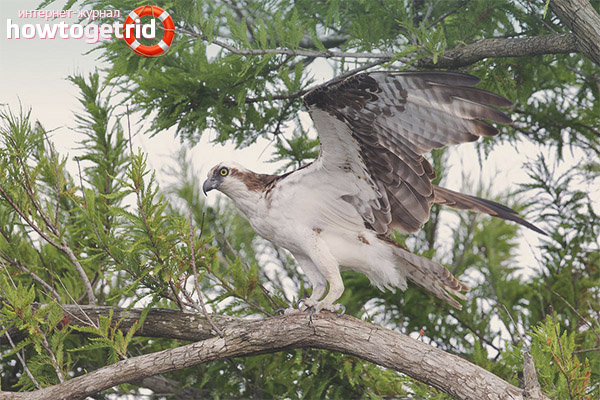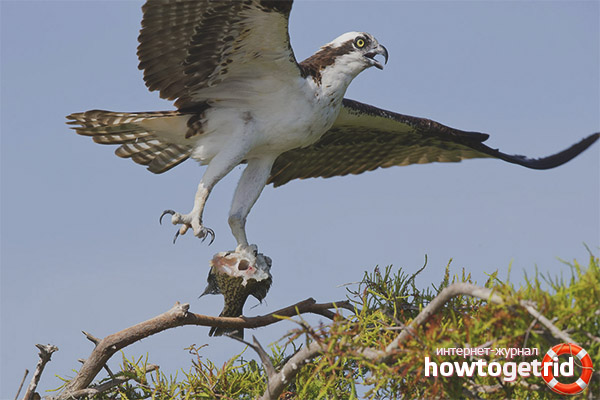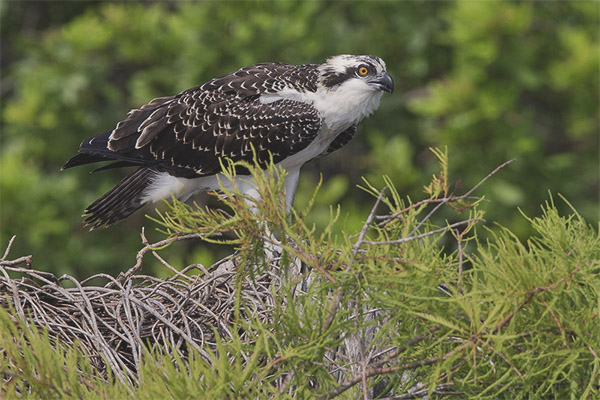The content of the article
The nature of our planet is rich in a large number of diverse types of amazing and beautiful birds. Some of them are quite common, and some are very rare. It is to this category of rare birds of prey can be attributed such a species as an osprey. Further, the presented material will describe the features of the nature and appearance of this bird of prey, as well as what it feeds on, where it lives, and what is its natural habitat.
Osprey predators
The Osprey is a rare bird of prey, this species belongs to a rather extensive and widespread family of falcons. The natural habitat of this species is the northern and southern hemisphere. The length of the bird’s body reaches 58 cm, the wingspan of the osprey is up to 170 cm.
The upper part of the plumage of the body of the osprey characteristic brown tint, lower part of the body, as well as the nape of the bird - white. Carpal joints are decorated with dark brown spots.Also, the same spots, but smaller sizes, also cover the neck area, which creates the appearance of a beautiful necklace of pebbles worn on the bird. Brown stripes crossing almost the entire body of the bird, from the beak and eyes to the bottom of the sides, deserve special attention.
The Osprey has a rather low, short but strongly convex beak of black color. A characteristic feature of this part of the bird's body is the hooked end. The paws are in the bird and the waxberry is of a light, lead color. Note that in this species of falconry family of paws are long, decorated with convex, curved and rather large claws.
Another feature of this species of birds of prey is that the large outer finger of the osprey can rotate in different directions, which significantly helps the predator in hunting and firmly holding the caught prey.
Osprey wings have a water-repellent effect, this is especially important when a bird descends on water for hunting. Water-repellent grease secreted gland, located in the tail section of the body. Also, the structure of the predator's nostrils provides for the presence of a special valve that prevents water from entering the respiratory tract - in the event that the osprey in order to grab the fish you like, dives behind it under the water.This is especially true when the predator captures a large enough fish that can resist, thereby pulling the bird along into the depths.
The color of young individuals of the osprey is more variegated and bright; nevertheless, the appearance of adult birds attracts more attention due to the beautiful plumage with original coloring and rather rigid feathers.
Note that such a bird of prey as an osprey is rightfully considered a long-liver, the duration of its life is several decades. But in fact, often the majority of young birds die in a natural environment, barely having lived to be 2 years old.
Osprey's natural habitat, lifestyle features

Although the osprey is a very rare bird of prey, nevertheless, it is common on all continents, with the exception of Antarctica. With the onset of cold weather, the osprey, as a rule, fly to countries with a warmer and milder climate.
In the warm season, the osprey can be found in almost any part of Europe. The nesting places of these birds of prey are various natural bodies of water (shallow water). This is explained by the fact that it is in such places that the most fish are found, which gives the opportunity for the Osprey to prove themselves as excellent hunters.
As a rule, only those bird populations fly for wintering, the main habitats of which are the northern regions of our planet. Osprey populations in the southern regions are sedentary.
Having found the most attractive territory for life, predators often settle on it in small groups, as a rule, these are coastal areas characterized by a warm climate. The peculiarity of the osprey is that the arrangement of places for subsequent nesting of birds, as well as hunting, can be conducted jointly.
Ospreys have their nests away from water. For this reason, they are not always able to provide them with adequate protection, since they are mainly engaged in hunting. However, if a predator is at the moment of attacking a nest near it, it fiercely protects it from the encroachments of its adversary.
The task of the male is to provide the female with food during the laying of eggs. Often, while waiting for the appearance of future offspring, the male does not have time to provide both himself and the female with the required amount of food. In this case, the males bring food to the female from adjacent nests.
When the chicks hatched, adult birds, as a rule, do not leave the nest for a long time, except for hunting for offspring.
Food Features Osprey
Such bird of prey as an osprey is often called by many lovers of birds as a sea eagle. This is because the basic ration of the osprey is 80% fish. During the hunting process, the predator mostly tries to catch not too large fish, which swims almost under the surface of the water. This osprey tactic characterizes the physical characteristics of the bird - the predator cannot dive deep behind its prey.
As a rule, the osprey hunt begins with a span over the selected water body, the bird circling above it at an altitude of up to 40 meters, looking out for its future prey. After the fish is discovered, the predator abruptly rushes down, dropping clawed paws and spreading its wings upwards. As soon as the skop grabbed the prey, it immediately soars up into the air. Caught prey is always firmly held by a predator with two paws - this is done so that the caught animal does not interfere with the predator during the flight.
This species of birds starts its prey from the head, while the main body of the fish is practically not used by the predator (it belongs to the nest for feeding the female or is thrown out).
The success of the sea eagle hunt is directly dependent on several factors: weather conditions favorable for food extraction, as well as tides.
In addition to the fish that the osprey catches, the latter can also eat various small animals (both aquatic and living on land). We pay attention that this bird practically does not use water. This is because a sufficient amount of liquid is present in the fish caught by the crowd.
Breeding

It is important to bear in mind that the breeding season of the osprey can vary in its timing. For example, in sedentary populations, the breeding season occurs somewhat earlier than in migratory predators. The mating season for those birds that are sedentary and live permanently on the same territory - from December to early spring. The mating season of migratory osprey is the middle and the end of spring (from April to May).
Having chosen a female, the male osprey starts attracting its attention with all its might, often circling above the place of its nesting, thereby also scaring other applicants. After creating a pair, the birds begin the joint construction of a common nest. As a rule, it is the female that chooses the material for construction and its subsequent arrangement (dry branches, leaves, grass).
The laying of eggs is carried out by the female osprey not at once, but with some pauses, which have a duration of 1-2 days. Emerging chicks from early-laying eggs are often much healthier and stronger than the rest of the offspring, however, they do not always have enough of the food produced by their parents for full development. The average number of chicks that appear in a young pair of Osprey is from 2 to 4.
Hatching eggs is carried out by both birds for 40 days. For feeding the emerging chicks, the fish harvested by the male in the hunt is used.
The feeding process of the Osprey offspring implies that the bird neatly divides the fish, or part of it, brought by the male between the chicks. For this, she tears her carcass to pieces with sharp claws and beak. In order to warm the offspring by lowering the air temperature,the female uses her own plumage, thereby carefully wrapping the chicks and warming them with the warmth of her body.
Already after 6–7 weeks, osprey chicks start learning to independently feed themselves, watching their parents hunt for prey. With the onset of autumn, the offspring of the Osprey is ready for flight and the beginning of an independent life.
Video: Osprey (Pandion haliaetus)












To send